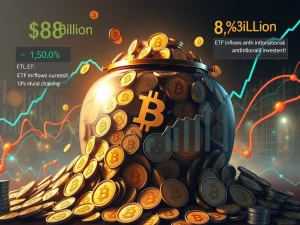Unveiling Bitcoin’s Enigmatic Split: Why Gold’s Record High Left BTC Behind

Cryptocurrency enthusiasts often seek patterns in the volatile digital asset landscape. However, recent events have presented a compelling puzzle. As gold surged to an unprecedented record high, the **Bitcoin price** surprisingly took a significant dip. This unusual divergence has prompted analysts to highlight Bitcoin’s ‘split personality,’ challenging long-held beliefs about its correlation with traditional safe-haven assets. This article delves into the forces behind this **market divergence**, offering insights into what it means for investors.
Understanding Bitcoin’s Dual Nature and Gold Correlation
For a considerable period, many observed a strong **gold correlation** with Bitcoin. Both assets, along with the Nasdaq, often moved in sync, particularly during periods of economic uncertainty. However, this pattern recently broke. IG market analyst Tony Sycamore points out this isn’t entirely new, attributing it to Bitcoin’s ‘split personality.’
- At times, Bitcoin functions as a **safe haven asset**, attracting investors seeking protection from inflation or economic instability.
- Conversely, it frequently acts as a risk asset, fluctuating with broader market sentiment and liquidity.
This dual nature means Bitcoin’s behavior can shift unexpectedly, leaving investors questioning its true role in a diversified portfolio. Understanding this dynamic is crucial for navigating the evolving crypto market.
The Recent Market Divergence: Gold Soars, Bitcoin Dips
The recent **market divergence** became strikingly clear when gold’s price soared to an all-time high. On Monday, gold reached an astonishing $3,485 per ounce, marking a 1% spike. This surge followed US President Donald Trump’s social media comments on Sunday, where he claimed, “prices are ‘WAY DOWN’ in the USA, with virtually no inflation.” Such statements often fuel investor demand for traditional inflation hedges like gold.
Conversely, Bitcoin (BTC) moved in the opposite direction. It fell to its lowest level since early July, hitting $107,290 on Coinbase. This represented a significant correction, exceeding 13% from its mid-August all-time high. The stark contrast between gold’s ascent and Bitcoin’s decline has certainly caught the attention of market watchers, highlighting a temporary breakdown in their usual correlation.
Questioning the Bitcoin-Gold Correlation: Expert Insights
Experts are actively discussing the implications of this decoupling. Vince Yang, co-founder of Ethereum layer-2 platform zkLink, offers a direct perspective. “These days, Bitcoin and gold aren’t really moving together,” he told Crypto News Insights. He added that the correlation has been “pretty low, even negative at times this year.” Yang emphasizes that gold remains the classic ‘safe-haven’ play. In contrast, Bitcoin is more closely tied to liquidity and overall market risk. “Basically, they balance each other out rather than run side by side,” he concluded.
This perspective suggests that investors might increasingly view these assets as distinct rather than complementary in the short term. The differing responses to market stimuli underscore their unique underlying drivers. Therefore, while gold reacts to inflation fears and geopolitical stability, Bitcoin often responds to technological advancements, regulatory news, and broader risk appetite in the **crypto market analysis** sphere.
Historical Context and Future Outlook for Bitcoin Price
Despite the recent decoupling, some analysts believe the **gold correlation** with Bitcoin could eventually realign. Tony Sycamore suggests that if economic policies lead to persistent inflation, Bitcoin’s correlation with gold might reassert itself, pushing both assets higher. “It’s just a question from what level Bitcoin finds its toehold,” he notes.
Historical data also provides context. Bitcoin price rallies have historically occurred within 150 days of gold hitting new all-time highs. For example, gold’s peak above $2,000 in 2020 preceded Bitcoin’s surge the following year. Joe Consorti, head of growth at Theya, earlier this year highlighted that Bitcoin often follows gold’s directional bias with a lag of 100-150 days. Consequently, the current divergence might be a temporary lag rather than a permanent split. Investors should monitor macroeconomic factors closely, as these will likely influence the future trajectory of **Bitcoin price** and its relationship with traditional assets.








